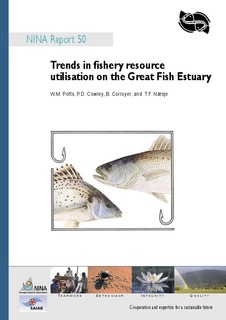| dc.description.abstract | Potts, W.M., Cowley, P.D., Corroyer, B. & Næsje, T.F. 2005. Trends in fishery resource utilisation on the Great Fish Estuary. - NINA Report 50. 34pp.
The Great Fish Estuary, located in the Eastern Cape Province, is becoming an increasingly popular fishing venue. A resource utilisation study consisting of a series of roving creel interview surveys was conducted in the estuary between March 200 I and February 2002 and between October 2003 and September 2004. During interviews with resource users, demographic informat ion as well as catch, effort, bait, duration of the fishing trip and number of rods/lines were obtained. Recreational shore fishers dominat ed during both study periods (54 %, both periods), followed by subsistence fishers (40 % - 1st st udy period, 23 % - 2nd study period) and recreat ional boat fishers (5 % - 1st study period, 23 % - 2nd st udy period). The increase in recreational boat fishers between the two study periods, was most probably attributed to the increased sampling on weekend days during the second study period and to the improved infrastructure at the Fish River Diner Caravan Park. Spotted grunter (Pomadasys commersonnii) and dusky kob (Argyrosomus japonicus) dominated the catches during both st udy periods. The overall catch per unit effort was lower during the second (0.19 fish/angler-hour) than during the first (0.22 fish/angler-hour) study period, while the distribution of fishing effort was more widespread during the second study period than in the fi rst . The total fishing effort during the second study period was twice as high (122 044 hrs), while the total catch was only o ne third higher (18 978 fish) than in the first study period (60 436 hrs and 12 752 fish, respectively). Results from the two study periods were used to make recommendations for the design of future estuarine fishery surveys. While the study showed a variety of short -term fluctuations, long term monitoring studies are recommended to examine trends in the Great Fish Estuary fisheries and other estuarine fisheries in South Africa.
Subsistence fishery, recreational fishery, bait fishery, datacollection protocols, management | nb_NO |
